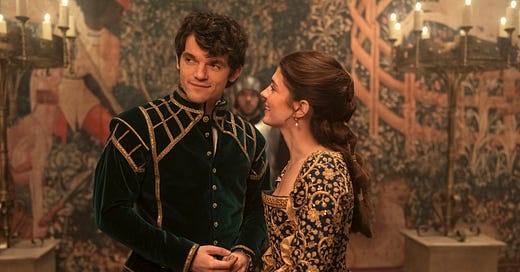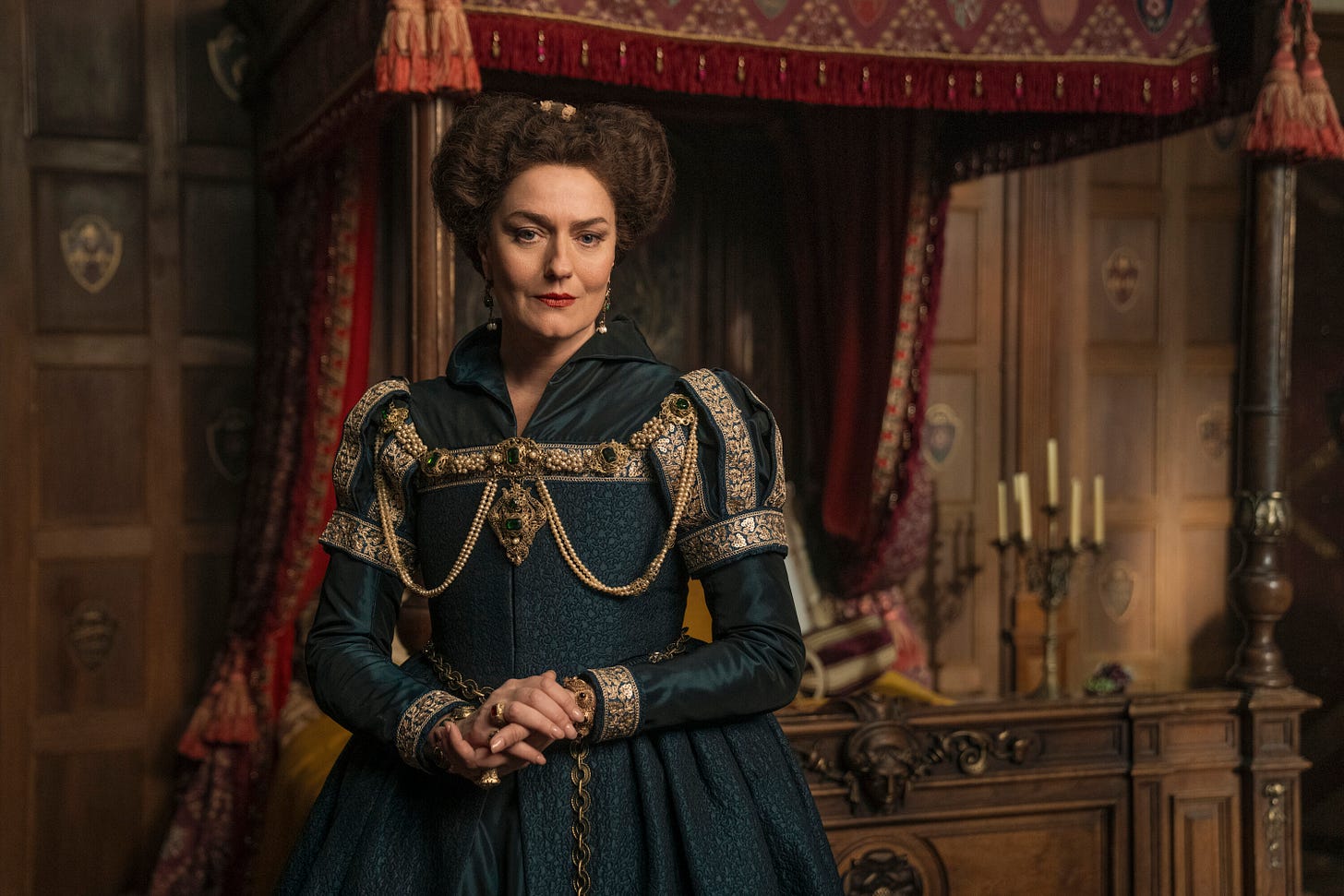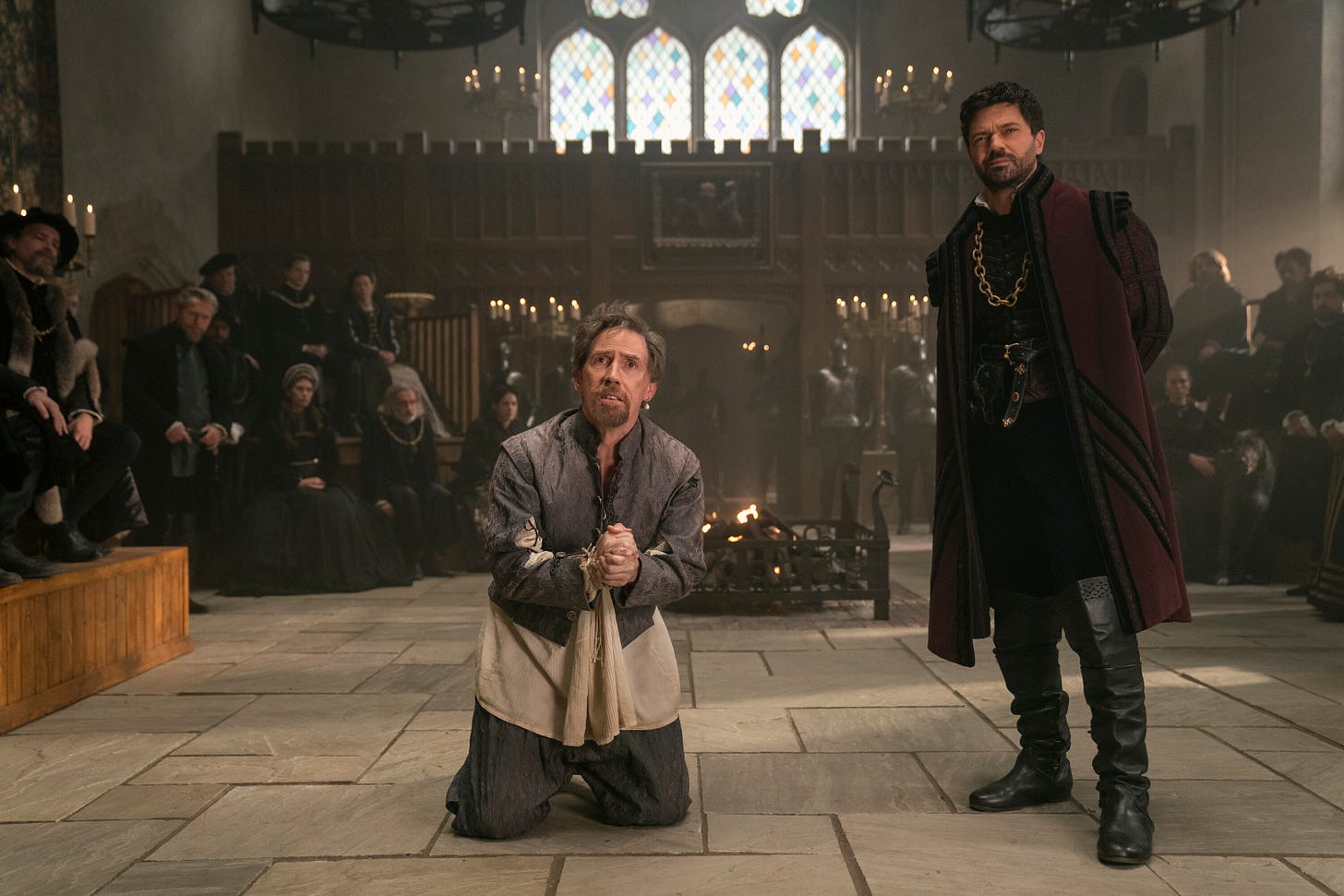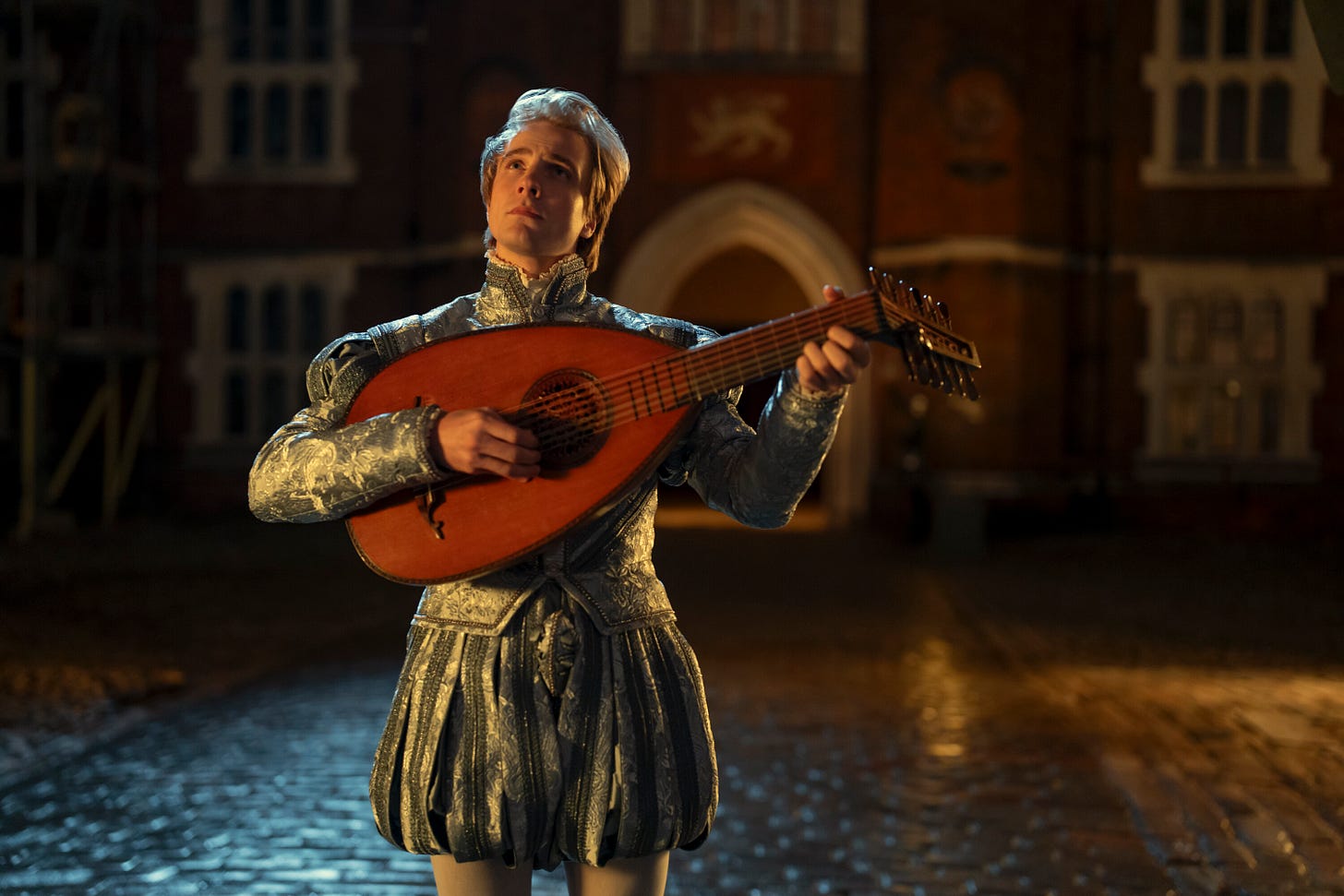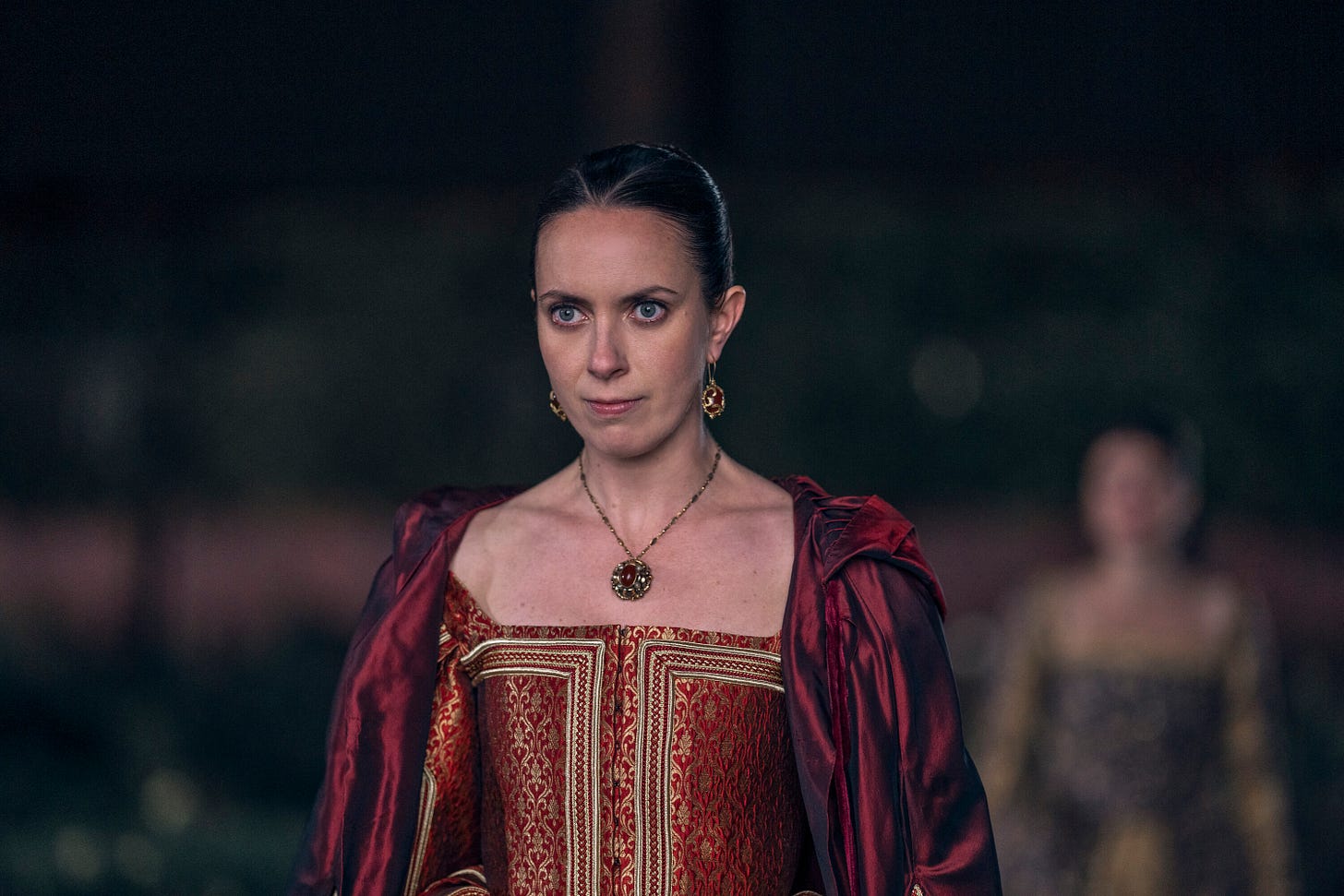Notes on 'My Lady Jane' Season 1 Episode 4: "Bluebird Is Dead"
On My Lady Jane's cancellation and a hysterical, heartbreaking mid-season finale
This newsletter now has a paid subscription available. If you enjoy my writing and want to support this newsletter, please consider becoming a paid subscriber for $5/month.
I did not expect to begin this letter with a bit about My Lady Jane’s cancellation.
I was confident — for once — that this show would get at least two seasons. Unfortunately, My Lady Jane joins an ever-growing list of great TV programs canceled after only one season. It’s heartening that many people, including the well-known writer George R. R. Martin, have shared their upset. Martin wrote about it in his blog post titled “Some Stuff and Nonsense” in early September. He wrote about working with My Lady Jane co-showrunner Meredith Glynn on a shelved Game of Thrones spinoff series and complimented her work.
Martin also wrote, “Witty and original, it reminded me a bit of THE GREAT, a show I loved. Alas, THE GREAT is gone, and it appears MY LADY JANE is too. Amazon did not renew it for a second season.” The Game of Thrones author also shared a link to more information on the #SaveMyLadyJane campaign and petition. Martin ended his post with, “I wish them luck. Jane deserved more than nine days, or eight episodes.”
As of writing this letter, that petition to save My Lady Jane has an impressive 103k signatures. I’m not sure what can or will come of it, but I’m all for people supporting art, especially when it continues to be cut down.
So, if you want to sign the petition, you can do so here.
It’s almost too fitting that my first letter about the show after its cancellation is about My Lady Jane Season 1 Episode 4, “Bluebird Is Dead.” The only other fitting episode would be the season finale (I’m still in too much denial to call it a series finale, okay?). This episode is entrenched in all kinds of grief. How writer Cathy Lew, director Jamie Babbit, and the cast harness that powerful force makes this “Bluebird is Dead” a hysterical and heartbreaking mid-season finale.
But, before I go even further, I have to applaud My Lady Jane’s continued attention to detail — down to the soundtrack. This episode gets its name from the Electric Light Orchestra song of the same title about grieving a loved one. It’s the perfect contextual lead-in for “Bluebird Is Dead,” where Jane is enveloped in the grief of her dear cousin Edward, let alone her life prior to becoming the new monarch.
Written by Cathy Lew and directed by Jamie Babbit, “Bluebird Is Dead” is the hysterical and heartbreaking chronicle of Lady Jane Grey becoming Queen Jane. The title card even crashes to “MY QUEEN JANE” instead of “MY LADY JANE.” This episode is steeped in all the humor that My Lady Jane has come to wield with the same ease that Jane does a dagger, but it’s also entrenched in Jane’s all-encompassing loss. And, all at once, Jane becomes eclipsed by a royal persona.
My Lady Jane perfectly encapsulates that chaos with a brilliant line from the narrator after Frances curtsies to Jane: “Jane has been in shock for hours, but her mother showing this level of respect and deference is, frankly, fucking bonkers.” “Bluebird Is Dead” is a crucible of political pressure and personal grief.
No scene captures that essence better than when Jane wakes up in Edward’s robe and in Edward’s bed. She is literally wrapped in the confines of her new role and her recent loss. After three episodes of a vastly different life, it’s no wonder that’s enough to make her sick. As My Lady Jane’s beloved Author says, “Grief doesn’t hit you all at once. It comes in waves like the world’s most lugubrious hangover.”
It’s very Lady — I’m sorry, Queen — Jane Grey to use that grief of her cousin and her former life as a motivation for answers. Jane is a woman of science, so it’s not shocking that she turns to evidence and facts for closure. It’d be more shocking if she didn’t! However, it is heartbreaking to watch her retrace Edward’s steps to find some clarity. My Lady Jane knows how to make that sequence a success — it doesn’t follow Jane into the room and then replay the events that just occurred.
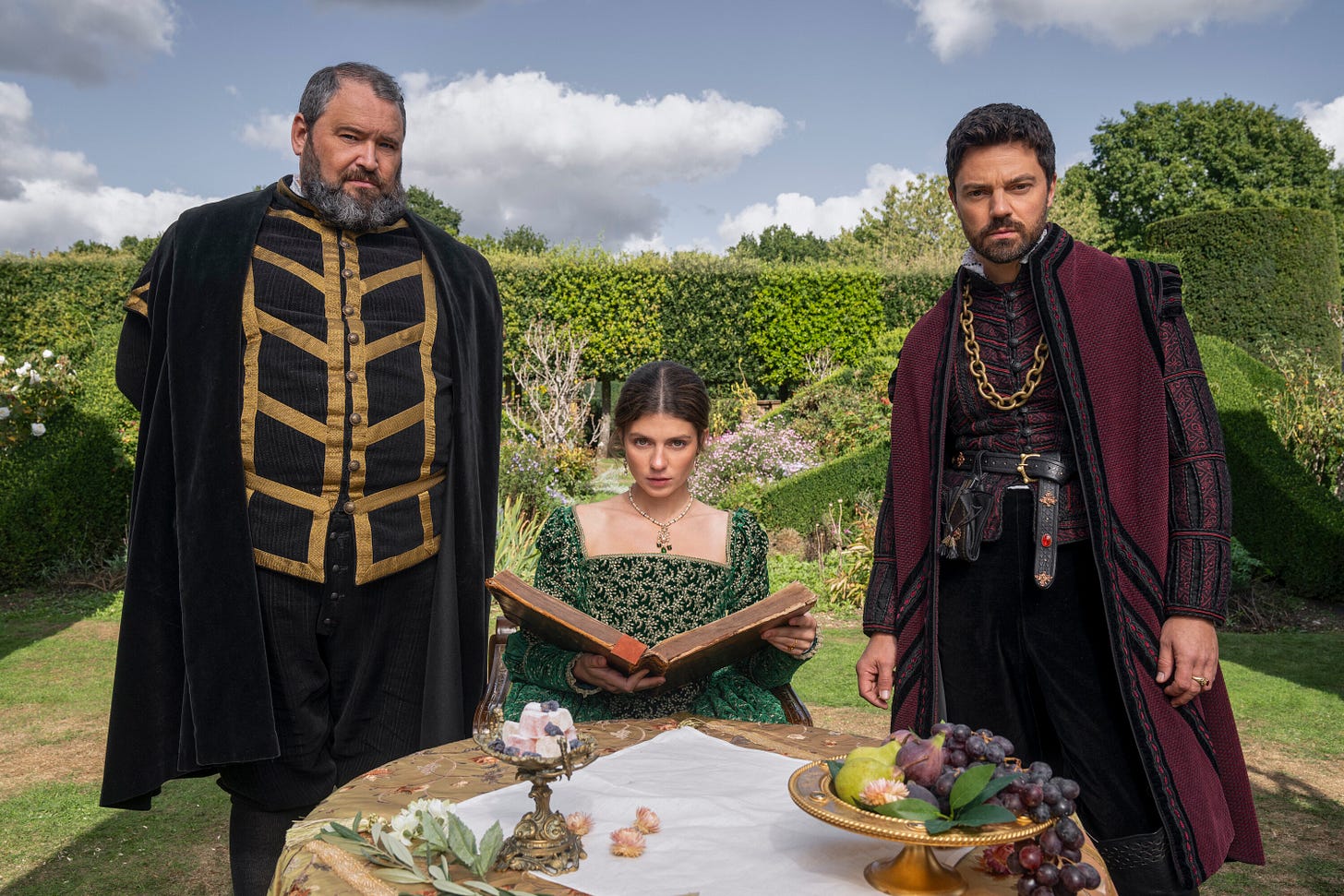
Instead of shoehorning flashbacks into the scene, “Bluebird Is Dead” stays with Jane, letting the impressive Emily Bader do the work. As the titular character imagines Edward’s final moments, Bader embodies Jane’s hesitance and determination to know the truth and the complicated tension between those within the character. My Lady Jane is better for sitting in those very real emotions with Bader as Jane while the events play out through an echoed memory.
It’s almost as chilling as the drafty castle from which Jane must live and rule.
That sequence reminds me of an interview with co-showrunners Gemma Burgess and Meredith Glynn. In discussing the “ick” of the Tudor era living on in My Lady Jane through things like dirt under nails and dirty hair, Glynn shared, “We like the ick. We wanted everything to feel lived in. We wanted the world to feel real.” I don’t think anything in that scene is contextually icky, but it certainly feels authentic.
It’s a fragile, vulnerable place to find Jane after such expositions of her various strengths. “Bluebird Is Dead” is smart to bring Jane and Guildford closer in her vulnerability and his sensitivity. Their scene in the stairwell feels like one of their dwindling opportunities for connection and privacy. Their safety in one another is special in such an unsafe place, and it’s a testament to their relationship’s positive development that Jane and Guildford realize it as such.
Those few minutes also stand as a reminder that Queen Jane Grey, like the other women on the show, contains multitudes that still aren’t always seen in female characters — let alone remembered about women throughout history.
Early on in “Bluebird Is Dead,” Frances tells Jane, “From now on, you must be calm, in control, and, above all else, regal.” The men around Jane — Lord Dudley, Stan Dudley, and Seymour, for example — are anything but one of those things. They are far from calm, rarely in control, and never regal. It is the women around her who embody those qualities, for better and worse. Multitudes and all of that.
It’s why Frances can believe Catherine’s…short-lived marriage, which she arranged, is why their family is “rich, safe, and happy,” but she won’t give herself the space to celebrate the luxury Jane’s reign brings her until she’s alone.
So, while Frances understands that the crown weighs heavier on Jane’s head as the first woman to wear it, she is also unafraid to be calculating in maintaining the life Frances believes she deserves. Hence, her incredible toast to herself at the dinner party and her declaration that she doesn’t need a husband in response to Stan’s early 2000s rom-com gesture set to a Tudor England backdrop.
It grates on Mary, who mourns her cherished spot as the first woman on the throne, to see Jane steal and squander (according to Mary) the privilege of Mary’s birthright. But even in her unlikability, My Lady Jane makes Mary interesting at every turn. The loyalty and love Mary wishes she had from Bess stands out as much as Mary’s affinity for her father’s coat, especially during sex, does.
(Want to read more about the real Mary? I suggest Ann Foster’s Vulgar History A La Carte posts about Queen Mary I in the Tudor? I Hardly Know Her series.)
Where Jane turns to tolerance to strengthen her leadership and, more importantly, society, Mary doubles down on intolerance and manipulates jailed Ethians to do her deadly bidding. My Lady Jane is interesting for many reasons, but one is how it handles these (still) prevalent social issues. It only does so through a world where husbands turn into horses and cooks turn into rabbits.
In a different interview, Glynn said, “We also think that it's one of the responsibilities of great storytelling to say something important about the world that we live in. So while the show is about this wonderful character in Jane, it is also saying something about our world.” The metaphor between Ethians (those who can transform into animals) and those who have been marginalized is obvious. “Bluebird Is Dead” doesn’t shy away from the hate-filled actions and language hurled at Ethians.
“Bluebird Is Dead” shows how absurd yet dangerous Mary and Seymour’s actions and rhetoric are, but it also cuts deep with Lord Dudley and Guildford’s heart-to-heart gone wrong. Rob Brydon and Edward Bluemel are fantastic in this scene, which also circles back to men clinging to power they don’t have through the women who do. For Joanna Goddard’s Substack, Burgess said, “I try to write with a sharp tongue and a warm heart.” I love how that comes through here.
Lord Dudley is skillful yet cutting in his manipulation tactics. It’s no wonder why he and Frances get along so swimmingly in the first episode.
He tells his son, “As a consort, you’re nothing. I mean, you’re, at best, a pretty toy. But, as King, you have power.” Bluemel’s physical reaction to Guildford’s father dehumanizing him, if only in example, is heartbreaking. Guildford’s frustration at realizing that Lord Dudley doesn’t want what’s best for his son but himself is expectedly met with Lord Dudley touting his personal sacrifices to protect Guildford and his “one flaw” that could “hold him back from greatness.”
It’s upsetting to watch Guildford see the worst in his father after vouching for his innocence. That reckoning makes Guildford telling Jane, “I don’t care what they say. The people that matter to me know exactly who I am” and “People are selfish and disappointing,” so important in the long run. Without divulging details (yet!), Guildford signals that Jane is one of the only, if not the only, person he trusts.
Considering the metaphorical snakes (The unnamed Ethian is not to blame here!) slithering around the royal grounds, Jane and Guildford’s bond is imperative.
The gasp-worthy ending of “Bluebird Is Dead” wouldn’t work without it.
After a sensational dinner party (a great, all-encompassing set piece for a mid-season finale, by the way), Jane confronts Mary about killing Edward to keep Mary from learning the truth about Guildford. This confrontation (Of course, Mary eats the evidence of the crime) proves how much Jane cares about Guildford.
In just four episodes, they have believably gone from thriving in disagreement to hating it. Jane is willing to risk avenging her dearly departed cousin, let alone her own life, to save Guildford. In turn, it’s a reverting twist that My Lady Jane ends with a red-caped fake-out, revealing Frances as the one who discovers the whole truth about Guildford. So, not only is Edward alive at the end of “Bluebird is Dead,” but Jane’s life is in peril, and Guildford’s secret hangs on by a thread.
Why wasn’t My Lady Jane released weekly again?
Until next time,
💌 Shelby


